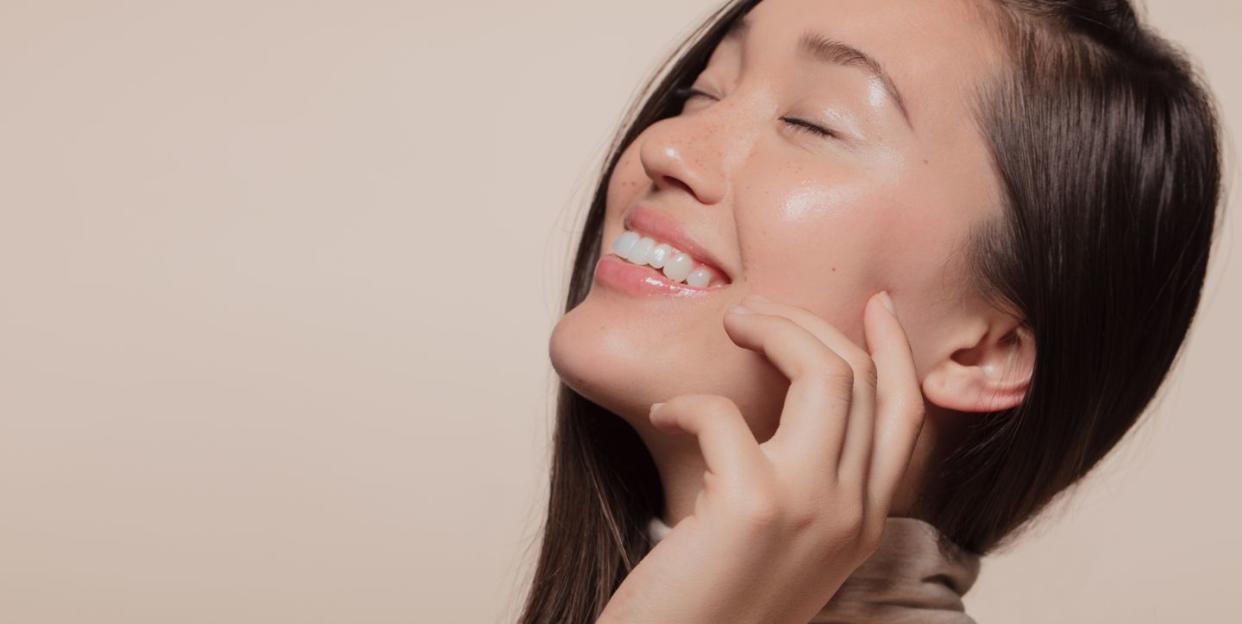Dermatologists Say Glycolic Acid Works Wonders on Age Spots, Clogged Pores, and Wrinkles

This article was medically reviewed by Mona Gohara, M.D., a board-certified dermatologist and member of the Prevention Medical Review Board on January 20, 2020.
Some anti-agers get all the attention: retinol, vitamin C, and hyaluronic acid, to name a few. But glycolic acid also belongs in the ranks of ingredients that keep your skin looking bright, plump, and smooth.
Glycolic acid is an alpha hydroxy acid (AHA), a class of chemicals that gently exfoliate the skin, which also includes lactic, citric, and malic acids. But the ingredient is not exactly new, even though it’s been gaining popularity, says Joely Kaufman, M.D., a board-certified dermatologist at Skin Associates of South Florida. Derived from sugar cane, glycolic acid can be used both at-home topically (in the form of toners, serums, or creams) or as an in-office peel in stronger concentrations, she says.
If you’ve used it before, you understand that post-glycolic fresh-faced feeling. That’s because “glycolic acid is the smallest molecule of the AHAs,” explains board-certified dermatologist Noëlle Sherber, M.D., co-founder of SHERBER+RAD and assistant clinical professor of dermatology at George Washington University. “It absorbs readily into the skin where it loosens the bond between dead skin cells, so that they can be swept away easily.” Cue the glow.
Your dermatologist can take you through pro treatments, but we’ll be talking about the OTC glycolic acid products to check out, what they can do for your skin, and what to know before you go all in with the potent ingredient.
What are the benefits of glycolic acid?
Because glycolic acid sweeps away dull, dead cells, your complexion becomes smoother and more even toned, says Dr. Sherber. That means that over time, glycolic acid can lighten dark spots or light freckles that are forming on the tops of your cheeks from too much time in the sun.
This serious sloughing will also help de-gunk pores, while helps reduce acne and allows other active ingredients to enter deeper into skin where they can get to work. Over time, by triggering collagen production, glycolic acid can help lessen the look of wrinkles and firm skin, adds Dr. Sherber. It’s also been found to boost the production of hyaluronic acid, a natural component of skin that keeps everything looking plump and hydrated.
So many ingredients in skincare sound good, but this one is the real deal. “Glycolic acid is one of the better studied and understood skincare ingredients,” says Dr. Sherber. One 2013 review pointed to past research, which found that 8% glycolic acid bettered skin brightness and lessened discoloration after 22 weeks; other trials showed that compared to a control, a 5% glycolic acid product evened texture and discoloration.
Are there any side effects of glycolic acid?
If you have sensitive skin, you may notice that your face feels like it burns or peels after using glycolic acid. In this case, just stop using the product. Dr. Sherber also cautions that if you have a darker skin tone, using a glycolic acid product that inflames your skin “can trigger darkening of the skin, called post-inflammatory hyperpigmentation,” she says.
No matter your skin type, the skin around the eyes is generally thinner and more sensitive, so avoid applying it to eyelids (or even close to them). And, since it’s an exfoliator, your skin may be more sensitive to sun exposure, so it’s generally best to apply it at night. Dr. Sherber recommends using a mineral-based face sunscreen (meaning it includes ingredients like zinc oxide or titanium dioxide) the next morning.
Lastly, a warning: “Please do not purchase a medical grade, high concentration peel for at-home use. This will likely result in a bad outcome including possible burns, hyperpigmentation, or even scarring,” says Dr. Kaufman.
Okay, so who should not use glycolic acid?
If you know your sensitive skin doesn’t tolerate glycolic acid—or you have a condition like eczema or psoriasis—talk to your dermatologist about your options. He or she may recommend using a different active ingredient for your problem areas, or starting with other AHAs instead.
Also know that if you’re pregnant, there are some products that your doctor will caution you against using, like retinoids. But glycolic acid is one anti-aging ingredient that is safe during pregnancy, says Dr. Sherber.
How to use glycolic acid in your skincare routine
Since glycolic acid is sloughing off the top layer of skin, it may trigger dryness or irritation in some people, especially with sensitive complexions. If that’s you, Dr. Sherber recommends using an AHA product that is rinsed off, like a mask.
You can also try a glycolic acid-based face cleanser. When applied for a short period of time and then washed off, there’s less of a likelihood of suffering side effects, like dryness, redness, and flakiness, says Dr. Kaufman.
If your skin is more tolerant, use glycolic acid as part of a nighttime toner, serum, or moisturizer, which will maximize its anti-aging potential, since “skin is in repair mode during sleep,” says Dr. Sherber. Start with just once per week and gradually work up to every other day to avoid excess irritation.
Just note that if you use a retinoid, it’s probably too harsh to use with a glycolic acid product in a nightly routine. Your best bet is to alternate the glycolic acid product every other day with a retinoid, once your skin gets used to it. Alternatively, you can find a combination AHA-retinoid product, like Skinbetter Science AlphaRet Overnight Cream ($125, available through dermatologists), which specifically formulates these two ingredients together to maximize their potential and minimize skin side effects. Ready to give it a shot? Check out some expert-approved products below:
Like what you just read? You’ll love our magazine! Go here to subscribe. Don’t miss a thing by downloading Apple News here and following Prevention. Oh, and we’re on Instagram too.
You Might Also Like

